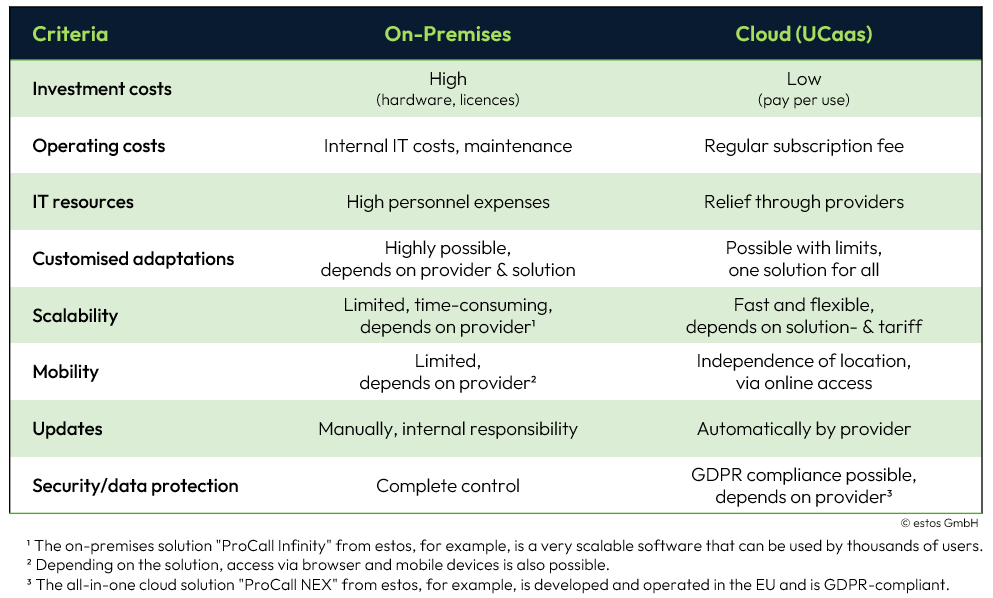From a “nice to have” to a “must” of modern communication
Future-proof, economical and low-maintenance – these are the requirements that companies place on software solutions such as unified communications and collaboration. At the same time, the products used should increase efficiency and productivity and optimize employees’ day-to-day work. This presents decision-makers with challenges when selecting the product and the associated technology.
What is Unified Communications and Collaboration? A definition.
Unified communications integrates communication channels such as telephony, text, audio and video chat, presence display, online meetings and collaboration in one platform. UCC – Unified Communications and Collaboration – makes internal and external communication and collaboration more effective, with employees working in a central interface. Companies can install the solution on-premises or obtain it as “UC as a Service”, or UCaaS for short, via a cloud.
What advantages does UCaaS offer? An overview.
Compared to countries such as Finland or Sweden, Germany is reluctant to use cloud communication solutions. Still. Studies by Grand View Research forecast annual growth of over 18 % for the German UCaaS market. And rightly so! UCaaS has a number of advantages to offer:
- Cost transparency: High one-off costs for hardware are eliminated, instead billing is based on usage.
- Centralized maintenance & updates: Functions are maintained centrally, without any effort for the internal IT team.
- High availability & scaling: New users or functions can usually be added flexibly and quickly.
- Mobile & hybrid working models: Employees work from any location with a consistent user experience.
- Future-proof: Used functions, integrations and security standards are updated automatically.
What are the prejudices against UCaaS? The selection criteria.
The advantages of UCaaS speak for themselves: they meet the modern requirements of companies in terms of productivity, cost-effectiveness and efficiency almost perfectly. So why are German companies skeptical? Data protection concerns, loss of control, effort, downtime and costs are the main fears. These need to be taken seriously. The UCC cloud solution should be selected carefully. Questions such as “Is the UCC cloud solution GDPR-compliant?” and “Can I still assign role-based user rights myself?” should be answered with “Yes”. It should also be verified that the changeover will take place with as little downtime as possible. A cost breakdown should show that the subscription model is cheaper than buying a license and also offers advantages such as flexibility and scalability. And those who end up using the software should not be forgotten either: The user interface should be simple and intuitive.
UCC on-premises or from the cloud? The fact check.
Investment costs, maintenance, scalability, mobility, updating and security & data protection – an overview of the differences.

What should I bear in mind when introducing UCaaS? The tips.
Once a company has decided to introduce UCaaS, it is now necessary to go even deeper into the selection of suitable software. In this process, the people involved should consider the following topics, among others:
- Communication goals
In which specific areas should communication be improved? Should internal accessibility be increased, mobile employees better integrated or collaboration optimized? - IT integrations
Which CRM system or databases are in use? Do you work with Microsoft Teams? Do mobile devices play a role? To what extent should the UCC cloud solution be integrated into the existing IT structure? - Security concept
Does the UCC cloud solution fit into my security concept? Is the hosting location in the EU? Is the required encryption possible? - Change management
How do I get employees excited about the new solution?
ProCall NEX from estos? An example.
ProCall NEX is a complete cloud UC solution. It helps small businesses, medium-sized companies and large corporations with distributed locations to optimize communication and collaboration. The software from the manufacturer estos offers special benefits:
- Quick introduction: Test free of charge, apply settings, use live
- Full range of functions: proven business telephony and UCC
- Free choice of device: Communication via PC, laptop, smartphone
- Flexible pricing models: Four scalable tariffs, optional device-only users for fax machines, DECT, factory hall or conference phones
- Automated updates: New functions without manual effort
- Maximum security: developed in Germany, hosted in the EU, GDPR-compliant
- Multi-client capability & site networking: Ideal for distributed organizations
UCaaS "nice to have" or "must"? A conclusion.
Future-proof, economical and low-maintenance: unified communications and collaboration from the cloud is no longer an optional add-on or “nice to have”, but a “must” and the key to modern and agile corporate communication. Solutions such as ProCall NEX from estos show this: Getting started is quick and easy, true to the motto “Just do it.”
Would you like to find out more about ProCall NEX or test the software free of charge for 30 days – 500 free minutes included?
Sources:
- Cloud usage in the EU in 2023: https://www.stackscale.com/blog/cloud-adoption-eu-enterprises
- UC as a service – market size and outlook in Germany: https://www.grandviewresearch.com/horizon/outlook/unified-communication-as-a-service-market/germany
- Development of the UCC market: https://www.globalgrowthinsights.com/market-reports/unified-communications-and-collaborations-market-114727

